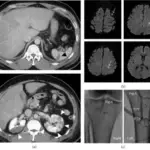Pulmonary embolism is a common and serious clinical complication of DVT, resulting from fragmentation or detachment of the venous thrombus.
What is the Pathology of Pulmonary Embolism?
The pathology of pulmonary embolism is:
-Etiology: The cause of pulmonary embolism is venous thromboembolism (VTE) arising from the deep veins of the lower limbs.
-Genes involved: None.
-Pathogenesis: The sequence of events that lead to pulmonary embolism includes deep venous thrombi to detach and embolize to the pulmonary circulation. The most common source is deep venous thrombus (DVT) of the lower extremity. Pulmonary infarction can occur if a large or medium-sized artery is obstructed. Ten percent of pulmonary embolisms cause infarction.
-Morphology: The morphology associated with pulmonary embolism shows wedge-shaped, hemorrhagic parenchyma and fibrinous pleural exudate which may eventually scar.
-Histology: The histology associated with pulmonary embolism shows neutrophils present if septic emboli and ischemic necrosis of the lung substance within the area of hemorrhage, affecting the alveolar walls, bronchioles, and vessels.
How does Pulmonary Embolism Present?
Patients with pulmonary embolism typically affect males present at the age range of 40 and above, mostly in the advanced age. The symptoms, features, and clinical findings associated with pulmonary embolism include pleuritic chest pain (sharp & stabbing pain, well localized, exacerbated by deep inspiration), breathlessness, hemoptysis, collapse, tachycardia, and hypotension.
How is Pulmonary Embolism Diagnosed?
Pulmonary embolism is diagnosed using CT scan, D dimer test, Ventilation-perfusion scan, and pulmonary angiogram.
How Is Pulmonary Embolism Treated?
Pulmonary embolism is treated with anticoagulants and thrombolytics.
What is the Prognosis of Pulmonary Embolism?
The prognosis of pulmonary embolism is poor with 20-30% affecting more in men as compared to women.



